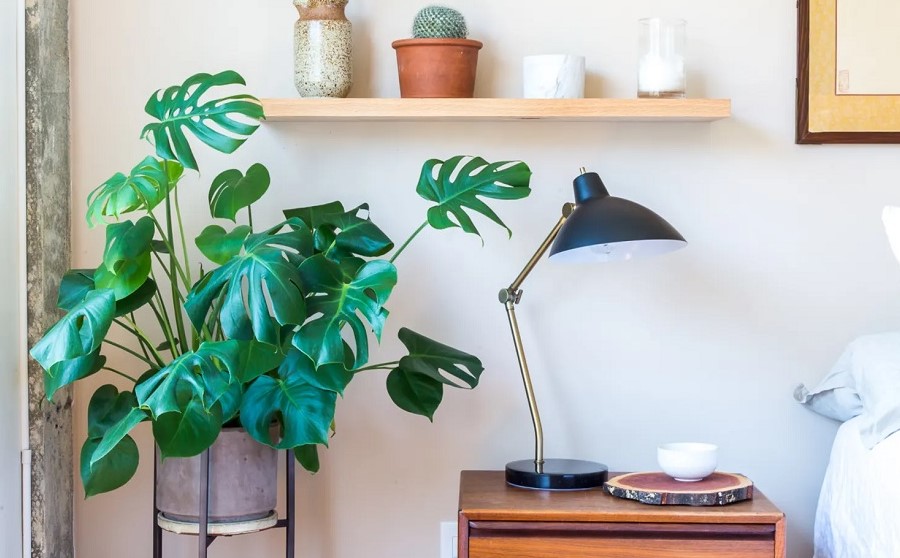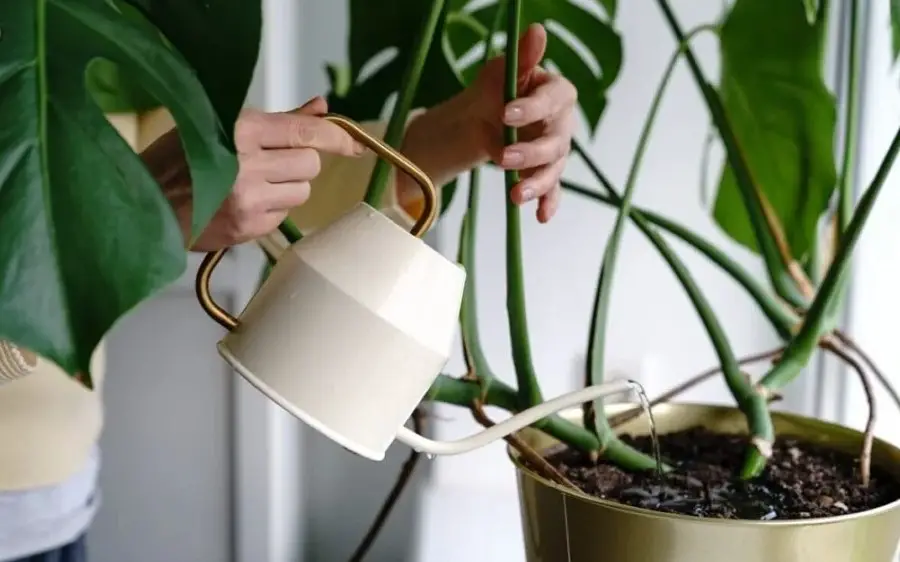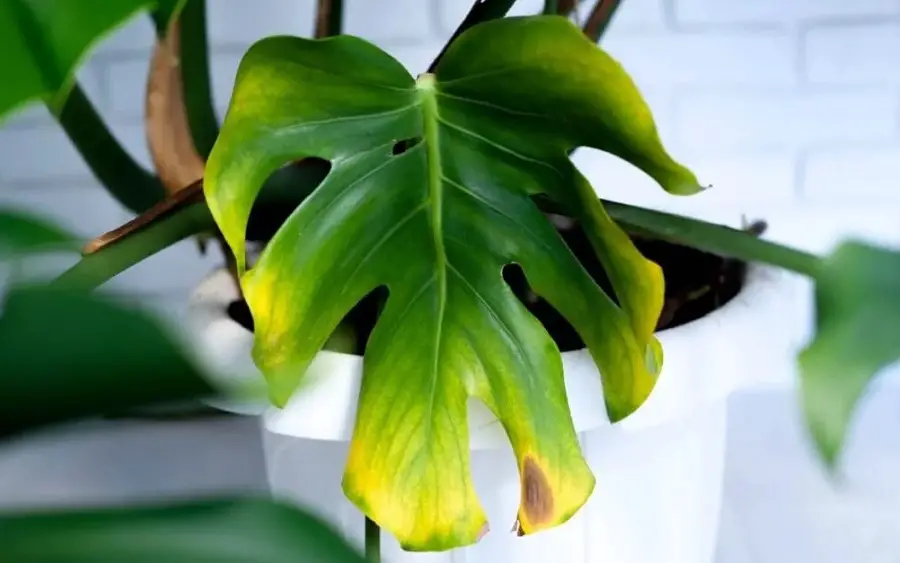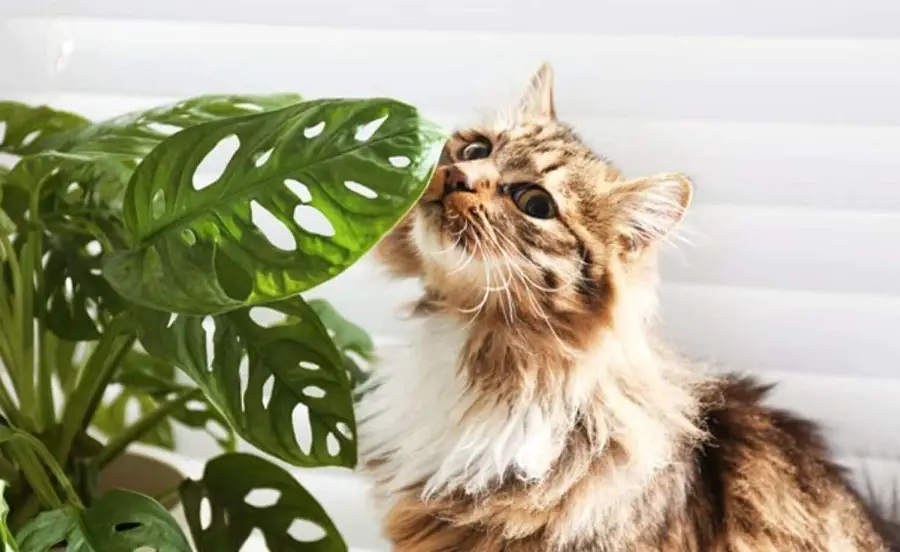There is a beautiful plant from the tropics, monstera acuminata, that is quite often in the homes of Americans. It has beautiful leaves and yellow-white flowers. Plant care is quite simple. If you want to grow monstera acuminata at home, this article is very useful for you.

Brief description of the monstera plants
Many are interested in the question, how do you identify a monstera acuminata? To answer this question, you need to compare it with other identical plants.
Growth features
Monstera acuminata is more like a vine in terms of growth characteristics. It is constantly looking for a place to grow up, while still a seedling. In this state, the plants produce thin stems that grow rapidly. Initially, they are not covered with leaves. Instead of leaf plates, nodal cataphylls are present.
If you care about the monstera acuminata, then active upward growth immediately begins.
Now small internodes and leaves appear around the entire perimeter. After that, leaves with holes begin to form on the bushes.
Dimensions
Monstera acuminata can reach 98 feet when grown outdoors. In the house, the height of the bushes does not exceed 4-8 feet. However, first, you need to prepare support along which the bush rises.

Sheet plates
All types of monstera acuminata have a stem with sheath wings. The vein, located in the center, is slightly bent. The base is uneven, and the top has a sharp peak.
The juvenile plant has green leaves that hang down. Some petioles stand straight. The length of the leaves is much greater than the width.
In addition, the leaves are located on the surface on which they grow. Often they interbreed.
Leaves are quite large when mature and can be up to 25 inches long and 14 inches wide. They hang and are completely covered with holes. On mature leaf blades, petioles are small, only 10-18 inches.
Stems
Young plants have long internodes, the size of which does not exceed 4 inches. The length can be up to 6.5 feet.
After the internodes are shortened and are no more than two inches. The stems become thicker.
Mature plants have smooth stems. Their internodes reach a length of 2.4-4.3 inches.
Flowers
Monstera acuminata has small inflorescences. Their shade can vary from yellow to cream. They are formed on the cob. The outer part of the flowers is green-white, and the center is creamy white.
Inside the house, flowering is quite rare. To see beautiful flowers, it is recommended to grow the crop outdoors. As the flowers mature, the cob begins to turn yellow.

Monstera acuminata vs esqueleto
Monstera acuminata differs from esqueleto in the size and shape of the holes on the leaf plates, as well as in the shade and texture of the leaves.
There are many more holes on the leaves of esqueleto, and they are all symmetrical. Their location can be seen along the central vein, from the center to the edges.
When esqueleto begins to grow, smaller holes can be seen next to the large holes. Monstera acuminata has dark green leaves, while esqueleto has lighter ones.
The texture is not smooth and the leaf sizes are larger. In esqueleto, the leaves move down, while in monstera acuminata, they move up.
Monstera plant care at home
Quite often, gardeners wonder, how do you take care of a monstera acuminata? After all, it is important to take know about many factors.
Lighting for monstera plant
The monstera plant like good lighting. However, it should not be bright; otherwise, the growth is wrong. Growth may stop in dim light. Leaves turn yellow and wilt.
You cannot put the monster in the window because there is direct sunlight that can burn the leaves. They turn brown or black or disappear altogether. Indoor plants can be placed near a window in the morning or the evening when there is bright indirect light.
If the windows face east or west, the sunshine is more active in the morning and afternoon. Therefore, it is advisable to close the blinds a little to achieve bright indirect light.
This prevents damage to the leaves. If there is no way to dim the light a little, put the containers away from the window.
If little sunlight enters the house, it is recommended to install additional lamps. Outdoor plants also prefer diffused or indirect light. You can plant bushes under the trees.

Optimum temperature
Monstera acuminata can be grown outdoors in warm climates. If the air temperature is below 50℉, it is better to bring containers with flowers inside the house. If the plant was planted in the soil, it is recommended to cover it to avoid frostbite.
Houseplants prefer tropical conditions. The tolerate maximum temperatures should be 65-68℉. Even if it gets a few degrees colder, it does not bring any harm to the plant.
As soon as the air temperature drops below 55℉, the growth rate of monstera acuminata slows down.
Do not place containers with plants in places where the temperature changes frequently. That is, do not place them near a window or door to prevent drafts. Also, you cannot keep the monstera acuminata in places where air from the air conditioner enters.
How to water monstera acuminata correctly?
Monstera acuminata is undemanding to watering. Even if the potting soil is already dry, the plant survives. However, overwatered monstera acuminata can have root rot. This causes the death of beautiful plants.
Try to plant the young tropical plant in containers that have drainage holes at the bottom. Thanks to this, excess water drains into the pan, which is placed under the pot. Before you start watering the flower, it is recommended to check the level of soil moisture.
Checking potting soil moisture is fairly easy. You need to insert a finger into the ground, deepening it 2 inches. Then take it out and see if there is wet soil on it.
If the soil sticks to the skin, then watering is not required. If the soil is dry at this depth, you must pour in a little water.
In order not to constantly use your finger, it is recommended to use a special wooden pin, which allows you to monitor soil moisture. Indoor flowers are recommended to be watered no more than once a week.
Make sure that the ground does not turn into a swamp. If a large amount of water flows into the pan and remains for about 20 minutes, then it is better to drain the excess. This prevents waterlogging and root rot.
If growing monstera acuminata in a hot and dry climate, water twice a week. If you put the plant near the window, you have to water the flowers much more often.
This is because the sun’s rays provoke the rapid evaporation of moisture.
The watering schedule should be based on lighting, temperature, and humidity levels. If the plant is dry, the leaves turn yellow and become covered with brown spots.
At the same time, they hang down. Partially, the soil moves away from the walls of the hill.
If the plant lacks moisture, the leaves are crisp and wrinkled. In winter, monstera acuminata needs to be watered much less often than in hot weather.

Humidity indicators
Monstera acuminata prefers to grow in high humidity. The level should reach 60%. This is the only way to achieve rapid growth. The plant feels good at a humidity of 40-50%. If the indicators are below the recommended rate, the leaves begin to dry. The edges turn brown.
Raising the humidity level is done in several ways. You can spray the moisture with plain water. The procedure is carried out twice a week.
You can also use a tray filled with pebbles. It must be placed under a pot of water. This cause the moisture to evaporate and increase the humidity.
If you prefer the second option, make sure that the pot is on the rocks. There should be enough of them so that the top does not become wet. Otherwise, the pot that is lowered into the water, that provoking root rot.
How to spray
Monstera acuminata bushes should be sprayed twice a week. It is advisable to use water at room temperature, which must be allowed to settle.
Periodically, it is necessary to wipe the sheet plates from the accumulation of dust. To do this, you can use a clean and slightly damp cloth.
Features of fertilizer application
Monstera acuminata needs a balanced fertilizer. That is why you need to choose compounds that contain potassium, nitrogen, and phosphorus. Experienced gardeners are advised to pay attention to Miracle-Gro top dressing. This is a universal composition that dissolves in water.
It contains an equal amount of nitrogen, phosphorus, and potassium – 20 g each. It is quite easy to use such compounds. It is necessary to dilute 1 tsp. in 1 liter of water, and pour according to the instructions. Fertilizers should be applied when the active growing season begins.

When to feed?
Indoor plants do not need to be fed in winter and autumn. In the cold season, they are at rest, so active growth is not observed. If you decide to feed an outdoor plant in the fall, growth likely resume.
Because of this, the plant can freeze as soon as the air temperature drops. To keep the leaves green and beautiful, it is recommended to feed once a month. If there is enough fertilizer solution for one procedure, and the mixture is still left, storage should be carried out in a container with a lid.
Before the next use, shake the container thoroughly so that all components are mixed. Try not to remove the lid between uses. After all, the components evaporate and do not bring the desired result. On the contrary, the composition is stronger, so it can burn plants.
Pruning
When grown at home, the bush should be supported with a trellis or stick, or the foliage should be pulled with a rope. After the growth of the old monstera acuminata slows down, it is recommended to cut off the top of it. This stimulates the growth of shoots that are located on the side.
Aerial roots: when do you need a sphagnum moss? Why can it be a root rot?
Each leaf plate grows aerial roots, it is strictly forbidden to cut them off. These roots are recommended to be lowered into a container in which the flower itself grows, or into an additional pot filled with fertile soil.
This improves the nutrition of the entire flower. If these roots grow very slowly and do not reach the surface of the substrate in a pot, then it is recommended to tie them with moistened sphagnum moss or immerse them in a bottle filled with water.
If desired, you can buy a plastic pipe, which should be wrapped with dry palm fiber. It is recommended to make several holes in it, and pour a nutrient substrate with sphagnum moss inside. The aerial roots of the flower must be directed into these holes.

Bloom
Monstera acuminata growing in natural conditions is distinguished by annual flowering. If the bush grows at home, then monstera acuminata rare blooms. If the plant regularly receives enough nutrients, then after a couple of years it can release a large inflorescence with bisexual flowers.
They are part of the cob with a cream cover. In a ripened fetus, the cover is covered with bark and disappears. The length of the purple seed is about 20 centimeters, outwardly it resembles a corn cob.
After that, the formation of small and juicy fruits pressed against each other occurs. They are very sweet and have a rich aroma. It resembles a combination of pineapple and strawberries.
How to transplant a monstera plant? What monstera acuminata soil is needed?
Transplanting a beautiful tropical plant is quite simple. It is carried out with an interval of 2-3 years. If it is noticeable that the roots have begun to break out of the drainage hole, this indicates that the plant no longer fits in the pot allotted for it. Therefore, an urgent transplant is required.
For the transplant to be successful, it must be carried out in spring or summer. It is during these periods that the active process of vegetation begins. Try to prepare a container for transplanting that is a few inches wider than the previous pot.
After the plant is abundantly watered. Then you need to take hold of the stems, which are located at the bottom, and tilt the container slightly to the side. Carefully remove the flower, including the earth ball.
Gently straighten the root system, and place the plant in a new container. First, it must be filled with nutrient soil mixed with sphagnum moss or peat moss. Put the monstera acuminata on top of the mixture with sphagnum or peat moss, and cover the potting soil. However, it should not be filled out completely.
It is recommended to step back from the edge about 1 inch. Thanks to this, during irrigation, water not be splashed all over the windowsill or floor. After transplanting, the plant must be well watered, and wait for the excess water to drain.

Virulence
As you know, monstera acuminata belongs to the category of poisonous plants. However, this is not a reason to panic. The juice of the plant contains components that can provoke inflammation of the mucous membranes, or irritate the skin.
Fruits that are not yet ripe have juice. If the fruits are consumed, they can cause bleeding in the digestive system.
They often cause inflammation of the oral mucosa.
Propagate monstera acuminata
Many gardeners are wondering, how do you propagate monstera acuminata? It is important to note that the breeding process is quite simple. You can use stem cuttings and put them in a pot filled with compost. You can also put stem cuttings in a glass of water. In the first case, rooting occurs faster.
Monstera acuminata breeding is best done in early spring. Pour the nutrient mixture into the pot, and thoroughly moisten it. Choose a good and healthy stem that is 4-6 inches long. There must be at least two nodes with aerial roots on the stem.
Before cutting the stem, you need to prepare the tools. Secateurs or scissors should be treated with rubbing alcohol to kill all bacteria. Otherwise, bacteria get inside the plant, provoking illness and death. You need to cut the stem a little below two nodes.
Cut off the lower leaves on the stem so that only one leaf plate remains on top. Put a cut in a growth stimulator to speed up the rooting process. Make a small hole in the soil and place the stem in it. Tamp down the soil and add sphagnum moss support.
Treat the stalk with water from a spray bottle, and cover it with a bag. Make sure that it does not touch the sheet plates. Make an incision at the top of the package to build a light greenhouse. Place the cutting near a window, however, make sure that it is not exposed to direct sunlight. Remove the bag several times a day to spray again.
Rooting begins in a few weeks. Often the process can take months. It’s impossible to influence it. If you prefer to observe rooting, the procedure for preparing stem cuttings is identical. However, there are several differences.
First, you need to infuse filtered water overnight. This allows the chlorine to dissolve in the water. Place the lower part of the cutting in water, however, make sure that the leaves do not touch it. Otherwise, they rot.
Place the container in a warm place away from direct sunlight. The best option would be a window sill. Change the water every few days. Once the roots have formed, plant the rooted cutting into the soil. You can not keep it in water for a long time because it can be root rot.

Possible problems
There are a few common problems that growers of monstera acuminata face. To identify them, and correct the situation in time, you need to constantly monitor the plant. The most common problems we describe below.
Changing the shade of the leaves and their wilting
If the monstera acuminata has begun to turn yellow leaves, it likely needs to be fed, or you are pouring too much water. From waterlogging, yellow leaves become denser.
If the plant is covered with leaves with brown edges, then there is not enough water. Therefore, it is urgent to irrigate. You need to check the level of monstera acuminata soil moisture before each watering.
Do not forget about the need for monthly fertilization. Often the plant requires them in advance. If this happens, do not ignore the message. Otherwise, you risk losing a beautiful flower.
Often, brown spots signal that monstera acuminata has been affected by a fungal infection – rust. Spots can appear on different parts of the leaf blades, while they differ in size. Most often, rust appears if water gets on the leaves when watering is carried out.
The fungus spread, causing the formation of spores in the form of a powder. They fall on other parts of the plant. Therefore, during watering, you need to work slowly so that moisture does not get on the leaf plates.

Pest infestation
Monstera acuminata is quite rarely affected by pests. If insects were noticed on the surface, the culture should be taken outside and watered with abundant pressure of water. Use a garden hose for this. This removes the insects.
Most often, thrips, scale insects, mites, and aphids appear on monstera acuminata bushes.
If pests were found on bushes that grow on the street, they can be treated with neem oil. It is quite effective against pests.
It is possible that processing is required several times a month to eliminate the infection.
Other common problems
If the monstera acuminata is not properly cared for or does not provide optimal conditions for growth, then problems may arise with it.
- Leaves fall. If the lighting is too poor, then the monstera acuminata begins to throw off the foliage, and there is also a suspension of its growth.
- The color of young leaf plates is pale. If the lighting is too intense, then faded leaves appear on the bush, and yellow spots may also form on their surface.
- The bush is pulled out. If the monstera plants do not have enough light, then their shoots become elongated, the stem twists, and the new leaf plates grow faded and small.
- Whole foliage. There may be no slots on young leaf plates because the flower feels a lack of light or nutrients.
- Foliage dries up and flies around. If the leaf plate turns brown and dries before falling, this means that the room is very hot. Also, the foliage flies around as it ages, but in this case, it does not turn brown.

FAQ
Growers face many questions when growing monstera acuminata. This often refers to its poisonous properties or similarities with other plants. Detailed answers to frequently asked questions are below.
What’s the difference between monstera adansonii and laniata?
Laniata is a subspecies of monstera adansonii. The leaves are slightly similar in size and shape. However, the difference lies in the shade. Monstera adansonii differs in that it has rich green leaves. You can even see your reflection in them due to the shiny surface.
Is monstera acuminata pet-friendly? Can monstera acuminata kill a cat?
If there is a cat in the house, try to avoid contact with monstera acuminata. After all, as already mentioned, the plant contains harmful substances.
There are calcium oxalate needles. They can damage not only the oral cavity, but also the intestinal mucosa. This can lead to the death of the animal.

Conclusion
As you can see, growing monstera acuminata is quite easy. The process of caring for it is standard, and even a beginner in gardening can handle it. However, the most important thing is constant surveillance of the state of the plant. If there are deviations from the norm, it is necessary to establish a care system.
- Why Are There Still No Tomatoes in My Tomato Plants? Let’s Fix the Issue! - July 13, 2023
- Water Propagation White Stuff on Roots: Everything You Should Know! - July 11, 2023
- String of Dolphins Drying Up: Solved! - July 11, 2023

